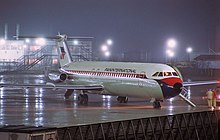Paninternational Flight 112
 D-ALAR, the BAC One-Eleven involved, seen nine months before the accident | |
| Accident | |
|---|---|
| Date | 6 September 1971 |
| Summary | Dual engine failure due to overheating after accidentally filling the water injection mechanism with jet fuel |
| Site | Bundesautobahn 7 53°42′10″N 09°56′33″E / 53.70278°N 9.94250°E |
| Aircraft | |
| Aircraft type | BAC One-Eleven |
| Operator | Paninternational |
| Registration | D-ALAR |
| Flight origin | Hamburg Airport, Hamburg, Germany |
| Destination | Málaga Airport, Málaga, Spain |
| Occupants | 121 |
| Passengers | 115 |
| Crew | 6 |
| Fatalities | 22 |
| Injuries | 99 |
| Survivors | 99 |
Paninternational Flight 112 was a BAC One-Eleven operated by German airline Paninternational that crashed in Hamburg on 6 September 1971 while attempting to land on an autobahn following the failure of both engines. The accident killed 22 passengers and crew out of 121 on board.
Aircraft[edit]
The aircraft, registered as D-ALAR, had its first flight the year before the accident.[1]
Accident[edit]
Paninternational Flight 112 took off from Hamburg Airport in Hamburg, Germany, on a flight to Málaga Airport in Málaga, Spain, with 115 passengers and six crew on board.[1] The captain was Reinhold Hüls, a former military pilot with more than 3,000 hours flying time; co-pilot Elisabeth Friske was the first woman jet pilot in West Germany, at the time with only 7 hours in the BAC One-Eleven.[2] After the takeoff, as the aircraft climbed through 300 metres (980 ft), both engines failed and the captain decided to make an emergency landing on a highway – Bundesautobahn 7 (also part of European route E45)[3] – about 4.5 km (3 mi; 2 nmi) from Hamburg Airport.[1] During the landing, on the south-bound carriageway to avoid heavy traffic out of Hamburg, the aircraft deflected to the left and collided with an overpass and multiple concrete pillars, causing the right wing, cockpit, and T-tail to shear off. The rest of the fuselage broke up and skidded to a halt resting against an oak tree, and subsequently caught fire.[1][2] The accident killed twenty-one passengers and one crew member.[1]
Cause of the crash[edit]
Subsequent investigation showed that the tank for the water-injection engine thrust-augmentation system (used during take-off) had inadvertently been filled with a mix of water and kerosene instead of with demineralised water. Spraying this additional jet fuel into the engines caused them both to overheat and fail shortly after take-off.[1][2][4] Two maintenance workers for Paninternational were sentenced to prison terms in 1974.[2]
See also[edit]
- Southern Airways Flight 242 a Douglas DC-9, which also crashed on April 4, 1977 during an emergency landing on a highway
- Dominicana DC-9 air disaster a 1971 DC-9 crashed caused by engines contaminated with water
References[edit]
- ^ a b c d e f Ranter, Harro. "ASN Aircraft accident BAC One-Eleven 515FB D-ALAR Hamburg-Fuhlsbüttel Airport (HAM)". Aviation Safety Network. Retrieved 8 February 2023.
- ^ a b c d Spaeth, Andreas (5 September 2021). "Absturz auf der Autobahn". Frankfurter Allgemeine Zeitung (in German).
- ^ "Autobahnatlas.de information for A7". www.autobahnatlas-online.de (in German). Retrieved 29 May 2010.
- ^ "Absturz auf der A7: Ein Wartungsfehler mit tragischen Folgen" (in German). Norddeutscher Rundfunk. 6 September 2021.
Further information[edit]
- Müller-Tischer, Jan (2013). Notlandung auf der A7: Die Flugzeugkatastrophe von Hasloh (documentary film, 27 mins, 43 secs) (in German).
